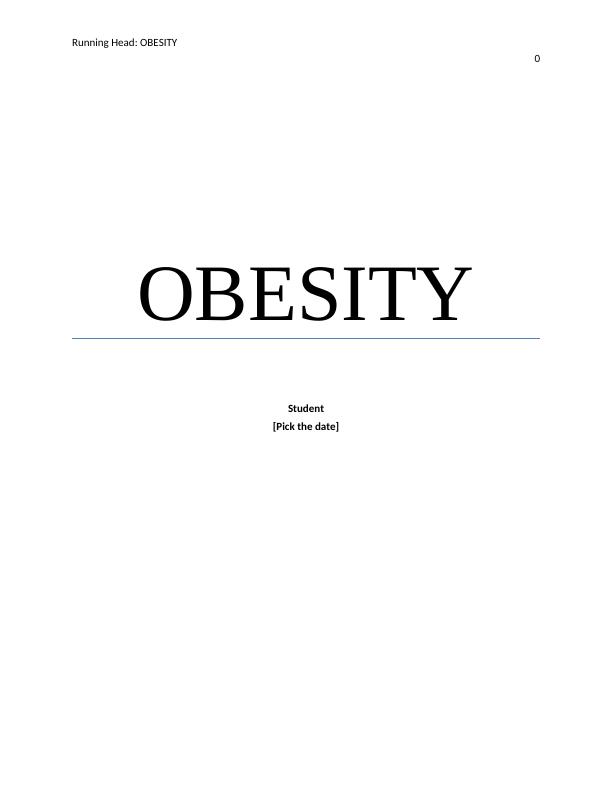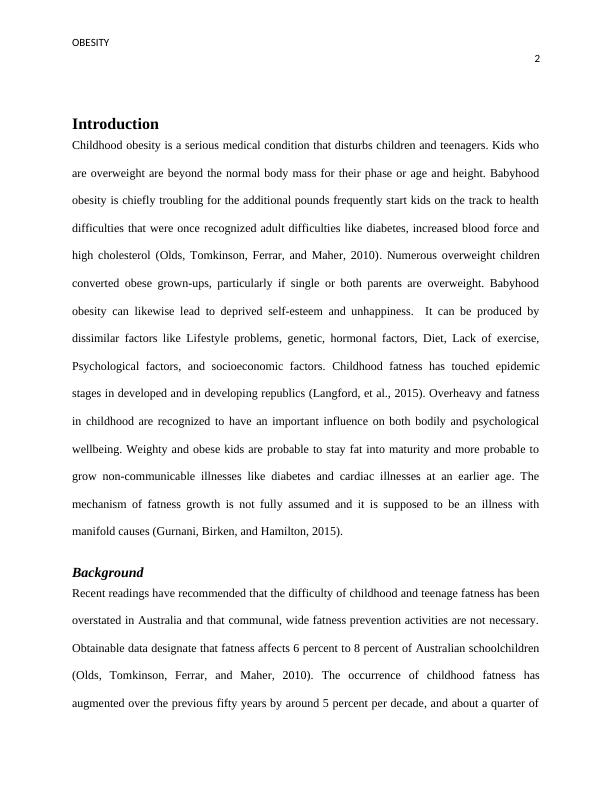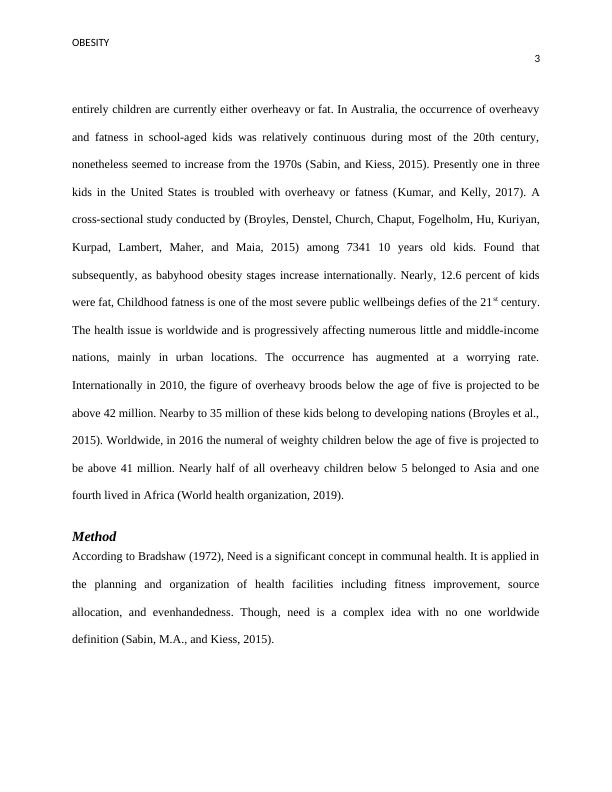Childhood Obesity: Causes, Consequences, and Prevention
Added on 2023-04-24
11 Pages2593 Words71 Views
Running Head: OBESITY
0
OBESITY
Student
[Pick the date]
0
OBESITY
Student
[Pick the date]

OBESITY
1
Table of Contents
Introduction.................................................................................................................................................2
Background.............................................................................................................................................2
Method....................................................................................................................................................3
Analysis...................................................................................................................................................4
Recommendation.........................................................................................................................................6
References...................................................................................................................................................8
1
Table of Contents
Introduction.................................................................................................................................................2
Background.............................................................................................................................................2
Method....................................................................................................................................................3
Analysis...................................................................................................................................................4
Recommendation.........................................................................................................................................6
References...................................................................................................................................................8

OBESITY
2
Introduction
Childhood obesity is a serious medical condition that disturbs children and teenagers. Kids who
are overweight are beyond the normal body mass for their phase or age and height. Babyhood
obesity is chiefly troubling for the additional pounds frequently start kids on the track to health
difficulties that were once recognized adult difficulties like diabetes, increased blood force and
high cholesterol (Olds, Tomkinson, Ferrar, and Maher, 2010). Numerous overweight children
converted obese grown-ups, particularly if single or both parents are overweight. Babyhood
obesity can likewise lead to deprived self-esteem and unhappiness. It can be produced by
dissimilar factors like Lifestyle problems, genetic, hormonal factors, Diet, Lack of exercise,
Psychological factors, and socioeconomic factors. Childhood fatness has touched epidemic
stages in developed and in developing republics (Langford, et al., 2015). Overheavy and fatness
in childhood are recognized to have an important influence on both bodily and psychological
wellbeing. Weighty and obese kids are probable to stay fat into maturity and more probable to
grow non-communicable illnesses like diabetes and cardiac illnesses at an earlier age. The
mechanism of fatness growth is not fully assumed and it is supposed to be an illness with
manifold causes (Gurnani, Birken, and Hamilton, 2015).
Background
Recent readings have recommended that the difficulty of childhood and teenage fatness has been
overstated in Australia and that communal, wide fatness prevention activities are not necessary.
Obtainable data designate that fatness affects 6 percent to 8 percent of Australian schoolchildren
(Olds, Tomkinson, Ferrar, and Maher, 2010). The occurrence of childhood fatness has
augmented over the previous fifty years by around 5 percent per decade, and about a quarter of
2
Introduction
Childhood obesity is a serious medical condition that disturbs children and teenagers. Kids who
are overweight are beyond the normal body mass for their phase or age and height. Babyhood
obesity is chiefly troubling for the additional pounds frequently start kids on the track to health
difficulties that were once recognized adult difficulties like diabetes, increased blood force and
high cholesterol (Olds, Tomkinson, Ferrar, and Maher, 2010). Numerous overweight children
converted obese grown-ups, particularly if single or both parents are overweight. Babyhood
obesity can likewise lead to deprived self-esteem and unhappiness. It can be produced by
dissimilar factors like Lifestyle problems, genetic, hormonal factors, Diet, Lack of exercise,
Psychological factors, and socioeconomic factors. Childhood fatness has touched epidemic
stages in developed and in developing republics (Langford, et al., 2015). Overheavy and fatness
in childhood are recognized to have an important influence on both bodily and psychological
wellbeing. Weighty and obese kids are probable to stay fat into maturity and more probable to
grow non-communicable illnesses like diabetes and cardiac illnesses at an earlier age. The
mechanism of fatness growth is not fully assumed and it is supposed to be an illness with
manifold causes (Gurnani, Birken, and Hamilton, 2015).
Background
Recent readings have recommended that the difficulty of childhood and teenage fatness has been
overstated in Australia and that communal, wide fatness prevention activities are not necessary.
Obtainable data designate that fatness affects 6 percent to 8 percent of Australian schoolchildren
(Olds, Tomkinson, Ferrar, and Maher, 2010). The occurrence of childhood fatness has
augmented over the previous fifty years by around 5 percent per decade, and about a quarter of

OBESITY
3
entirely children are currently either overheavy or fat. In Australia, the occurrence of overheavy
and fatness in school-aged kids was relatively continuous during most of the 20th century,
nonetheless seemed to increase from the 1970s (Sabin, and Kiess, 2015). Presently one in three
kids in the United States is troubled with overheavy or fatness (Kumar, and Kelly, 2017). A
cross-sectional study conducted by (Broyles, Denstel, Church, Chaput, Fogelholm, Hu, Kuriyan,
Kurpad, Lambert, Maher, and Maia, 2015) among 7341 10 years old kids. Found that
subsequently, as babyhood obesity stages increase internationally. Nearly, 12.6 percent of kids
were fat, Childhood fatness is one of the most severe public wellbeings defies of the 21st century.
The health issue is worldwide and is progressively affecting numerous little and middle-income
nations, mainly in urban locations. The occurrence has augmented at a worrying rate.
Internationally in 2010, the figure of overheavy broods below the age of five is projected to be
above 42 million. Nearby to 35 million of these kids belong to developing nations (Broyles et al.,
2015). Worldwide, in 2016 the numeral of weighty children below the age of five is projected to
be above 41 million. Nearly half of all overheavy children below 5 belonged to Asia and one
fourth lived in Africa (World health organization, 2019).
Method
According to Bradshaw (1972), Need is a significant concept in communal health. It is applied in
the planning and organization of health facilities including fitness improvement, source
allocation, and evenhandedness. Though, need is a complex idea with no one worldwide
definition (Sabin, M.A., and Kiess, 2015).
3
entirely children are currently either overheavy or fat. In Australia, the occurrence of overheavy
and fatness in school-aged kids was relatively continuous during most of the 20th century,
nonetheless seemed to increase from the 1970s (Sabin, and Kiess, 2015). Presently one in three
kids in the United States is troubled with overheavy or fatness (Kumar, and Kelly, 2017). A
cross-sectional study conducted by (Broyles, Denstel, Church, Chaput, Fogelholm, Hu, Kuriyan,
Kurpad, Lambert, Maher, and Maia, 2015) among 7341 10 years old kids. Found that
subsequently, as babyhood obesity stages increase internationally. Nearly, 12.6 percent of kids
were fat, Childhood fatness is one of the most severe public wellbeings defies of the 21st century.
The health issue is worldwide and is progressively affecting numerous little and middle-income
nations, mainly in urban locations. The occurrence has augmented at a worrying rate.
Internationally in 2010, the figure of overheavy broods below the age of five is projected to be
above 42 million. Nearby to 35 million of these kids belong to developing nations (Broyles et al.,
2015). Worldwide, in 2016 the numeral of weighty children below the age of five is projected to
be above 41 million. Nearly half of all overheavy children below 5 belonged to Asia and one
fourth lived in Africa (World health organization, 2019).
Method
According to Bradshaw (1972), Need is a significant concept in communal health. It is applied in
the planning and organization of health facilities including fitness improvement, source
allocation, and evenhandedness. Though, need is a complex idea with no one worldwide
definition (Sabin, M.A., and Kiess, 2015).

End of preview
Want to access all the pages? Upload your documents or become a member.
Related Documents
Obesitylg...
|8
|1433
|201